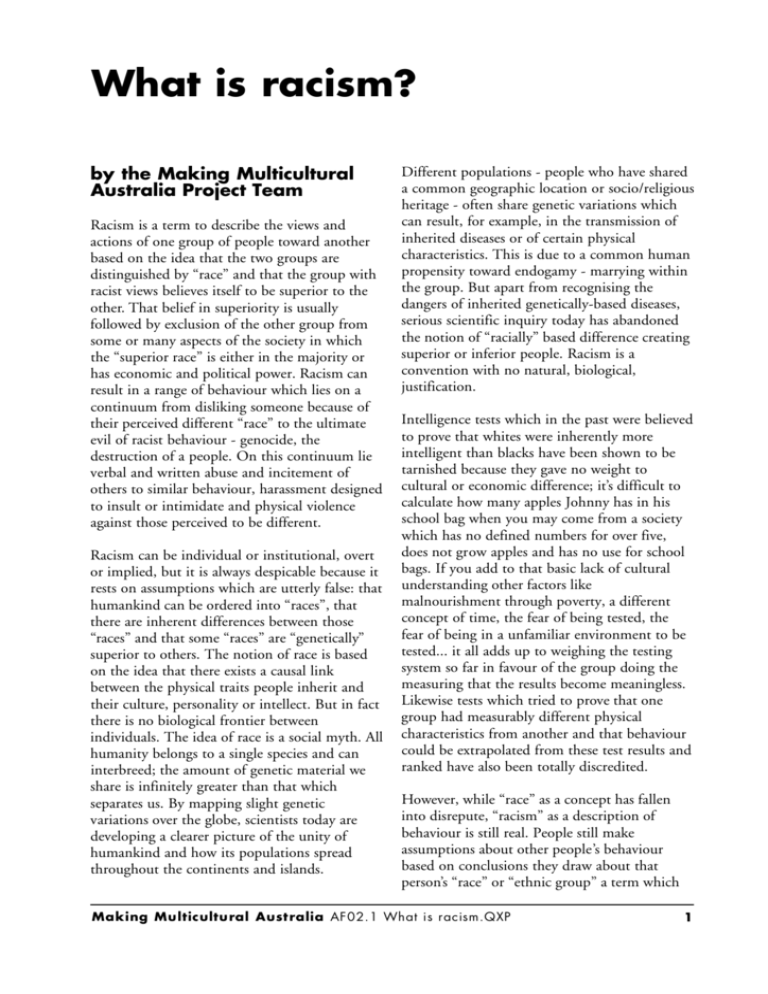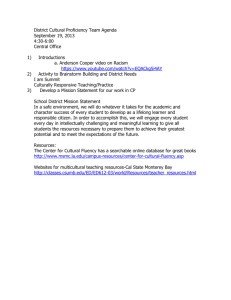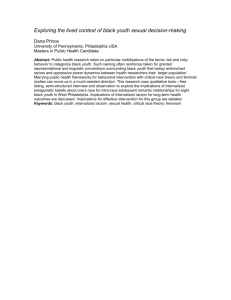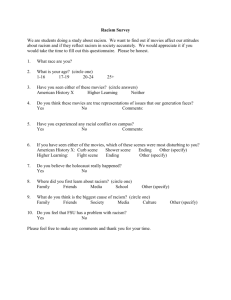What is racism?
advertisement

What is racism? by the Making Multicultural Australia Project Team Racism is a term to describe the views and actions of one group of people toward another based on the idea that the two groups are distinguished by “race” and that the group with racist views believes itself to be superior to the other. That belief in superiority is usually followed by exclusion of the other group from some or many aspects of the society in which the “superior race” is either in the majority or has economic and political power. Racism can result in a range of behaviour which lies on a continuum from disliking someone because of their perceived different “race” to the ultimate evil of racist behaviour - genocide, the destruction of a people. On this continuum lie verbal and written abuse and incitement of others to similar behaviour, harassment designed to insult or intimidate and physical violence against those perceived to be different. Racism can be individual or institutional, overt or implied, but it is always despicable because it rests on assumptions which are utterly false: that humankind can be ordered into “races”, that there are inherent differences between those “races” and that some “races” are “genetically” superior to others. The notion of race is based on the idea that there exists a causal link between the physical traits people inherit and their culture, personality or intellect. But in fact there is no biological frontier between individuals. The idea of race is a social myth. All humanity belongs to a single species and can interbreed; the amount of genetic material we share is infinitely greater than that which separates us. By mapping slight genetic variations over the globe, scientists today are developing a clearer picture of the unity of humankind and how its populations spread throughout the continents and islands. Different populations - people who have shared a common geographic location or socio/religious heritage - often share genetic variations which can result, for example, in the transmission of inherited diseases or of certain physical characteristics. This is due to a common human propensity toward endogamy - marrying within the group. But apart from recognising the dangers of inherited genetically-based diseases, serious scientific inquiry today has abandoned the notion of “racially” based difference creating superior or inferior people. Racism is a convention with no natural, biological, justification. Intelligence tests which in the past were believed to prove that whites were inherently more intelligent than blacks have been shown to be tarnished because they gave no weight to cultural or economic difference; it’s difficult to calculate how many apples Johnny has in his school bag when you may come from a society which has no defined numbers for over five, does not grow apples and has no use for school bags. If you add to that basic lack of cultural understanding other factors like malnourishment through poverty, a different concept of time, the fear of being tested, the fear of being in a unfamiliar environment to be tested... it all adds up to weighing the testing system so far in favour of the group doing the measuring that the results become meaningless. Likewise tests which tried to prove that one group had measurably different physical characteristics from another and that behaviour could be extrapolated from these test results and ranked have also been totally discredited. However, while “race” as a concept has fallen into disrepute, “racism” as a description of behaviour is still real. People still make assumptions about other people’s behaviour based on conclusions they draw about that person’s “race” or “ethnic group” a term which Making Multicultural Australia AF02.1 What is racism.QXP 1 today is often used instead of “race” to describe cultural, linguistic or religious differences between people. Yet while notions of superiority of one group over another appear to be as old as recorded history and widespread throughout the globe, the idea that this “in-group/out-group” division of society should hinge on a person’s “race” is little more than a century old. In Biblical times, in the ancient histories of eastern and western cultures, and in what we know of non-literate societies, difference was seen as a function of society, of culture and of education. Those who were different to the majority were “perfectable” if they learned the majority language, embraced the majority religion or adopted the customs of the majority society. Ruth the Moabite, in the Biblical story, despite coming from a people who were ancestral enemies of the Hebrews, became the ancestor of King David, and potentially of the Jewish and Christian Messiah, because she embraced the culture of her Hebrew husband and mother-in-law: “...thy people shall be my people and thy God, my God.” To the Greeks and Romans, the “barbarians” were those of different culture, religion and language; once they learned Greek or Latin, and Graeco-Roman custom, they could take their part in society. In the European Middle Ages, if pagans, Jews or Muslims converted to Christianity they were “saved” to experience earthly, as well as heavenly, bliss. This is not to say that difference was eliminated, or even that the “in-group” accepted totally the “out-group” despite their superficial conversion to “in-group” language, faith and values. But the intellectual underpinning of rejection or acceptance allowed for permeability, for movement through barriers; they were not closed systems. the belief that there were measurable differences between “races” - in externals like hair, skin and eye colour, eye shape, hair and skin texture, and in the more intangible fields of intelligence and adaptability. The “in-group/out-group” system became closed. In apartheid South Africa, the discovery of a black ancestor was enough to have someone reclassified from white to “coloured”; in Nazi Europe a Jewish grandparent was enough to send a Catholic priest to the gas chambers. Because of the history of colonialism and the Euro-centric nature of the literature about race and racism, in Australia we tend to assume that racism is a European failing. But racism and other “closed” systems which divide society have been practised in many non-European cultures. On the Indian sub-continent, for example, the caste system used to define a person’s place in society rigidly and immovably; in sub-Saharan Africa there have been innumerable tribal conflicts leading to devastation like the Ibo/Yoruba war in Nigeria and the current genocidal conflict between the Hutu and Tutsi of Rwanda and Burundi. In both the Indian and African examples, racism is a real phenomenon even if “race” is not in fact the distinguishing factor between groups. But during the nineteenth century, the theories of Charles Darwin about the evolution of species from lower to higher orders led to what is called social Darwinism, the notion that some peoples are genetically predisposed to rule and others, to be ruled. Inevitably European imperialists saw this to mean that whites were the natural rulers and black and Asian peoples natural subjects. Bolstering this argument was Making Multicultural Australia AF02.1 What is racism.QXP 2








